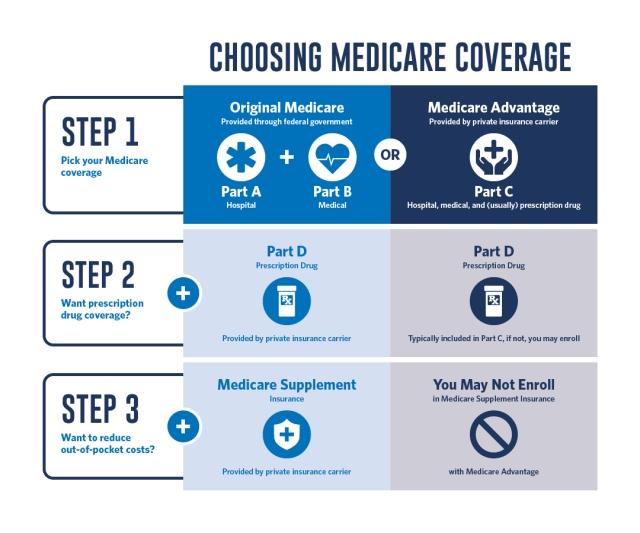What exactly is Medicare and why do you need it? There’s a lot of Medicare information available through various mediums and platforms, so figuring out what type of coverage is best for you may seem overwhelming. To help make things a little easier, here are five tips about Medicare that you might find helpful when looking for coverage that could meet your retirement needs.
1. The ABCs of Medicare
Medicare is a federal health insurance program for people 65 years of age and older, some disabled people under 65 years of age, and people with End-Stage Renal Disease (permanent kidney failure treated with dialysis or a transplant).
There are four parts of Medicare: Part A, Part B, Part C, and Part D. Here’s a quick breakdown to understand the different coverages and services associated with each part.
- Part A is under Original Medicare and provides inpatient/hospital coverage such as lab tests, surgeries, home healthcare, hospice, and skilled nursing facilities.
- Part B is under Original Medicare and provides outpatient/medical coverage such as durable medical equipment, home healthcare, and some preventative services. Under Original Medicare, the government pays directly for the healthcare services you receive, and it includes Part A and Part B. You can use any doctor or hospital that takes Medicare, anywhere in the U.S.
- Part C (Medicare Advantage) is offered by Medicare-approved private companies that must follow rules set by Medicare. It provides Part A and Part B and usually Part D. Some plans may offer benefits such as vision, hearing, and dental services.
- Part D covers prescription drugs and is only offered through private insurance companies. You pay a separate premium for Part D with Original Medicare.
Medicare Supplement Insurance (Medigap)
While not a part of Medicare, it’s still important to understand Medicare Supplement insurance as part of your options. You can buy Medicare Supplement insurance from a private company to help you manage out-of-pocket costs. With Original Medicare, you generally pay some of the costs for approved services. Medicare Supplement insurance can help you pay for the rest. With Medigap, you can get some coverage for medical emergency care outside the U.S. You cannot add Medigap with Medicare Advantage plans.
2. Coverage options
There are two main paths when enrolling in Medicare. You can enroll in Original Medicare (offered by the federal government), or you can choose a Medicare Advantage Plan offered by Medicare-approved private companies that must follow rules set by Medicare.
With Original Medicare, you’ll pay Medicare premiums, deductibles, and co-insurances (usually 20% of the Medicare-approved cost for outpatient care) for hospital and medical services. If you want prescription drug coverage, you can add a Part D plan. To close any out-of-pocket gaps left by Original Medicare, you may also enroll in Medicare Supplement insurance. You’ll pay separate premiums for Parts B, D, and Medigap (most people do not pay a premium for Part A).
If you enroll in a Medicare Advantage plan, you’ll get Parts A, B, and D through one private plan coordinated by the federal government. You may pay the Part B premium, and you pay an additional premium for the plan. Medicare Advantage plans, with cost-sharing out-of-pocket costs, vary by plan. In many cases, you may only use doctors in the plan's network and plans generally don’t cover medical care outside the U.S. You cannot add Medigap with Medicare Advantage.
You can also consult your spouse, employer, and/or former employer for other potential options that may be available.
3. Enrollment periods and how to avoid penalties
Medicare enrollment periods take place during different timeframes, so it’s important to understand when each occurs.
- Initial Enrollment Period (IEP) – The seven-month window when someone turning 65 is eligible to enroll in Medicare for the first time.
- Special Enrollment Period (SEP) – A specific timeframe when people in special circumstances can enroll in Medicare, such as continuing to work after age 65.
- General Enrollment Period (GEP) – A three-month Medicare enrollment window for those who missed their IEP. It runs from January 1 to March 31. Keep in mind, late penalties may apply to those who miss their IEP.
- Annual Enrollment Period (AEP) – The time each year when you can change your Medicare coverage choices. It usually runs from mid-October to early December.
Medicare eligibility usually begins at age 65 (some exceptions apply), but you can sign up earlier to make sure your coverage starts as soon as possible. You’ll have a seven-month IEP that starts three months before the month of your 65th birthday. If you sign up during the first three months of your IEP, your Medicare coverage will kick in on the first day of your 65th birthday month. If you sign up later, your IEP coverage could be delayed.
Part B and Part D may add late enrollment penalties to your premium payments if you enroll after your IEP ends and don’t qualify for a SEP. If you don’t qualify for premium-free Part A, you’ll also face late penalties for Part A if you miss your IEP. The Part B penalty is charged every month for as long as you have Part B, the Part D penalty is charged every month for as long as you’re enrolled in Part D, and the Part A penalty is charged every month for twice the number of years enrollment was delayed.
Note: Medicare's enrollment periods are not the same as Medigap's open enrollment period. You have one open enrollment period for Medigap and it's a six-month period that starts when you sign up for Part B, typically on the first day of the month you turn 65.
4. Think about what’s best for you
Everyone takes care of their health in different ways and what works best for some may not work for all. Take some time to think about how Medicare can help you.
- Consider how frequently you go to see your primary care provider
- Consider medications
- Consider any provider preferences
- Consider if you need specialists
- Do you plan to travel in retirement? If so, you’ll want to consider network implications.
Reflect on your future as well. You may not regularly see a physician or have significant health conditions now but could in the future. It’s important to prepare for potential unforeseen circumstances.
It may make sense to select the same coverage as a friend, family member, or spouse; however, there are reasons why Medicare is individual insurance.
Everyone has their own unique healthcare and financial needs, so we encourage you to decide which option best fits your life.
5. Where to get information
It’s important to gather as much knowledge as you can before the time comes to choose a plan — even if you’re under age 65. Take some time to get used to what Medicare offers.
State Health Insurance Assistance Programs (SHIPs)
SHIPs provide local, in-depth, and objective insurance counseling and assistance to Medicare eligible individuals, their families, and caregivers. These programs are available in all 50 states, Puerto Rico, Guam, DC, and the U.S. Virgin Islands.
Visit ShipHelp.org or call 877-839-2675.
Medicare Support Hotline and Medicare.gov
Call 1-800-MEDICARE (1-800-633-4227) to talk with a customer support representative about your Medicare questions and concerns — or visit the Medicare.gov website to start a live chat. TTY users should call 1-877-486-2048. The Medicare Support Hotline is available 24/7, except for some federal holidays.
Medicare.gov provides detailed information about how Medicare and the various types of Medicare plans work, as well as a Medicare plan finder tool and a guide to shopping for Medicare Supplement Insurance policies. A great resource is Medicare & You.
For disabled people under age 65 and people with End-Stage Renal Disease, please visit the following resources for more information and/or to sign up for Medicare.
- Medicare Information | Disability Research | SSA
- Medicare Coverage for People with Disabilities - Center for Medicare Advocacy
- Sign up for Medicare | SSA
Medicare coverage may seem like a challenging subject to wrap your head around, but with the right knowledge and tools you’ll be able to make your decisions with more confidence. You’ve got this!
Transamerica Resources, Inc., is an Aegon company and is affiliated with various companies that include, but are not limited to, insurance companies and broker dealers. Transamerica Resources, Inc., does not offer insurance products or securities. The information provided is for educational purposes only and should not be construed as insurance, securities, ERISA, tax, investment, legal, medical or financial advice or guidance. Please consult your personal independent professionals for answers to your specific questions.




